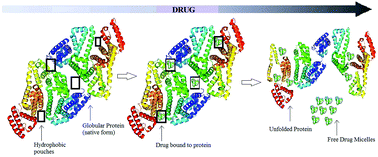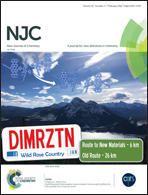Morphological changes in human serum albumin in the presence of cationic amphiphilic drugs†
Abstract
Human serum albumin (HSA) is one of the most important carrier proteins present in the blood and can constitute more than half of serum proteins. It transports various biomolecules including hormones, fatty acids, ions, and drugs and it functions to regulate oncotic pressure in the plasma. Cationic amphiphillic drugs like amitriptyline hydrochloride, imipramine hydrochloride and promethazine hydrochloride bind to HSA and influence its function by altering its conformation, as confirmed by Small-angle neutron scattering (SANS) data coupled with dynamic light scattering (DLS) measurements. Protein unfolding was observed by SANS results through an increase in the value of the radius of gyration Rg. At higher drug concentrations, there was no change in the dimensions of the protein. However, the drugs formed free aggregates at higher concentrations without any growth in the drug micelles, which was confirmed by the appearance of a second peak in the DLS measurements. Molecular docking revealed that the morphology of the hydrophobic moiety of the cationic amphiphilic drugs decides their binding fate with HSA, while trajectories from molecular dynamics simulations highlight structural disorder in the drug–HSA complex.



 Please wait while we load your content...
Please wait while we load your content...